Sorted by date Results 51 - 75 of 205
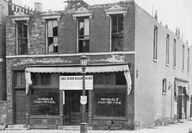
Special delivery - This photo in Sandy Williams' book, "Images of America - Hinsdale," is of the Hinsdale Post Office in 1894. "Established in 1867, the Hinsdale Post Office moved frequently about the downtown before settling at 53 S. Washington St. about 1894. Residents had to pick up their mail; home delivery did not begin until 1906, when carriers made three rounds daily throughout the village. The photograph shows the Washington Street location after it, but incredibly...
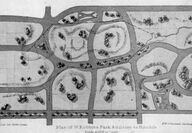
Early Hinsdale - This photo in Sandy Williams' book, "Images of America - Hinsdale," is of William Robbins' second addition to the village. "Hinsdale flourished and Robbins made two additions to the village. This, his second, 'Park Addition,' was designed in 1869 by well-known landscape architect H.W.S. Cleveland. Familiar with Olmsted and Vaux's curvilinear plan of Riverside, Robbins sought this new, more picturesque layout for the area that included his own home. Cleveland...
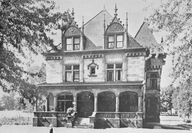
One look at this home at the southwest corner of Walnut and Lincoln offers a clue as to its first occupant. William Gates was president of the American Terra Cotta Co. He and his home have been well-documented in village annals, including Hugh Dugan's "Village on the County Line." See Page 7 for more coverage. (Hinsdale Historical Society photo)...

Back to school - This photo in Sandy Williams' book, "Images of America - Hinsdale," is of what was then called South Side School. "While reincarnated over the years, a Hinsdale school has always been located at Third Street and Garfield Avenue. Two years after this building's 1866 construction, William Robbins sold it to the newly created Hinsdale School District. At that time it was renamed South Side School to differentiate it from the Fullersburg School farther north....
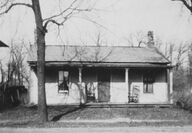
Pre-I-pass - This photo in Sandy Williams' book, "Images of America - Hinsdale," is of the Barto Van Velzer's home on Ogden Ave. "Located on the north side of the plank road near the county line, this was toll collector Van Velzer's home. Toll rates between Brush Hill and Naperville were 25 cents for a horse and carriage, 37 cents for a wagon with two horses, 10 cents for a horse and rider, 4 cents for cattle and 3 cents for hogs and sheep. For those who needed to stop...
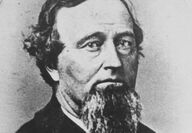
Early Hinsdalean - This photo in Sandy Williams' book, "Images of America - Hinsdale," is of Barto Van Velzer, who was a settler from the east. "Barto Van Velzer was a former boat driver on the Erie Canal. He helped lay the Southwest Plank Road and became the toll collector at Brush Hill upon its completion. Van Velzer had a reputation as a talented horse trader and was well liked by the stagecoach drivers and area farmers."...
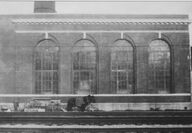
Powerful company - This photo in Sandy Williams' book, "Images of America - Hinsdale," is of Hinsdale Light and Power. "The village granted the power company a franchise and donated land for the plant north of the tracks, east of Garfield Avenue. Western Electric, then chaired by Hinsdale resident Enos Barton, was the lowest and winning bidder on the plant and power line construction. The newly completed plant is shown here in 1896."...
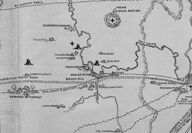
Before Hinsdale - This photo in Sandy Williams' book, "Images of America - Hinsdale," is of the front inside cover of Hugh Dugan's book, "Village on the County Line," which was published in 1949. "At the map's center is what is now York Road and Ogden Avenue. The plank road (Ogden Avenue) is shown running east to west through Brush Hill." For more information on the early days of Hinsdale, see the story on Page 7 and the editorial on Page 10....
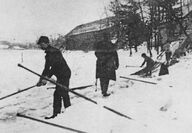
Icemakers - This photo in Sandy Williams' book, "Images of America - Hinsdale," shows ice being cut up and stored along the banks of Salt Creek near Washington and Spring Road. "Fullersburg's Mammoth Springs Ice Company, a prosperous natural ice business before the days of refrigeration, was begun by John Ruchty in 1880. When the ice on Salt Creek was about 16 inches thick, it was cut into 24-inch blocks. Workmen are shown maneuvering the floating ice to the horse-powered...
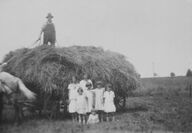
Hay mountain - This photo in Sandy Williams' book, "Images of America - Hinsdale," is of Hinsdalean Frank Kufrin. "The Kufrin home and farm was located on South Oak Street. This 1925 photograph shows Frank Kufrin on top of his hay wagon with his wife and six daughters posing proudly below." Do you have a Hinsdale photo that is at least 25 years old? We'd love to share it with our readers. Stop by our office at 7 W. First St. or email it to jslonoff@thehinsd...
Christmases past — Those lucky enough to be on Vinaya Sharma’s Christmas card list are always in for a surprise as to where he will stage his next scene. Twenty-five years ago it was at a USC football game. Hinsdalean Sharma is a graduate of Hinsdale Central High School and former District 86 board member. Do you have a Hinsdale photo that is at least 25 years old? We’d love to share it with our readers. Stop by our office at 7 W. First St. or email it to [email protected]....
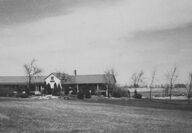
Early golf - This photo in Sandy Williams' book, "Images of America - Hinsdale," is of the club house at Ruth Lake. "Ruth Lake Country Club, shown about 1940, was founded in 1922 by some younger men in the village who had used this site along South Madison Street for hunting, camping and skate sailing. The club was named for Linus Ruth, a boyhood friend of the founders, who lost his life in World War I."...
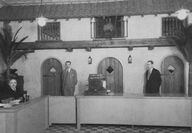
Cleaning up - This photo in Sandy Williams' book, "Images of America - Hinsdale," is of the building at 108-110 S. Washington St. "The building still standing at 108-110 S. Washington St. was built in 1925 by tailor Carl Theidel for his business, Hinsdale Cleaners and Dyers. The north side of this building housed this establishment where every sartorial need was satisfied in these tropical surroundings. Pictured are, from left to right, Carl, Harry, and Edwin Theidel in...
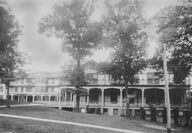
Hospital expansion - This photo in Sandy Williams' book, "Images of America - Hinsdale," is of what is now AdventHealth Hinsdale Hospital. "A 17-room addition was added to the existing home, and the Hinsdale Sanitarium opened in 1905. A healthy mind, physical therapy, diet and spiritual well-being were considered vital to the healing process. The sanitarium's tranquil setting provided an ideal atmosphere for this approach. Families were encouraged to participate in treatment...
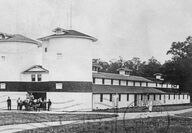
Got milk? - This photo in Sandy Williams' book, "Images of America - Hinsdale," is of Natoma, a farm north of Ogden. "George Robbins named his north side farm 'Natoma,' an Indian word for 'running water,' and began importing cows from Britain, some of the first Guernseys in the country. Trade journals later recognized the impeccable farm as the 'finest Guernsey dairy in Illinois.' This postcard of the twin-silo dairy barn dates from 1905."...
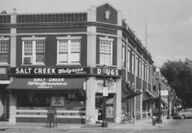
Early merchants - This photo in Sandy Williams' book, "Images of America - Hinsdale," shows Walgreens on the northeast corner of First and Washington streets. "Dr. Merrick's and Evernden's original 1872 drug store changed ownership and locations twice before Walgreens bought the business in 1935. It remained at the First and Washington Street location until closing in 1973. It was not until 1986 that Walgreens again had a presence in Hinsdale."...
A neat retreat - This photo in Sandy Williams' book, "Images of America - Hinsdale," shows the lodge at KLM. "The Katherine Legge Memorial Lodge, a dining and recreation hall for the women's retreat, was built in 1926. It was designed by Hinsdale architect R. Harold Zook based on an earlier plan for the Legge home intended for the site. A dormitory followed, along with tennis courts, swimming pool and a convalescent cottage. In December 1973, International Harvester donated the retreat property to Hinsdale for use by the...
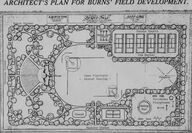
First park - This photo in Sandy Williams' book, "Images of America - Hinsdale," is of the plans for Burns Field. "Burns Field, designed by Edson Nott and local architect R. Harold Zook, was built with few changes from this 1932 plan, the first Hinsdale park with recreational facilities. Public Works Administration funds and Works Progress Administration labor were used for its completion with local men hired for the work."...
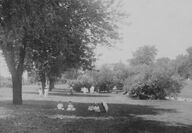
Park and recreation - This photo in Sandy Williams' book, "Images of America - Hinsdale," is of Burlington Park. "Hinsdale's first public landscaping endeavor took place at Burlington Park. After the railroad granted use of the site in 1877, fencing and evergreens were installed, When the new depot was built in 1899, the village acquired the remainder of the block, setting the stage for walkways and flower beds to showcase Hinsdale's "front yard." In this early photograph,...
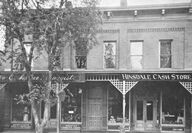
Can you hear me now? - This photo in Sandy Williams' book, "Images of America - Hinsdale," is of McGee's Drugstore at 49 S. Washington St. "Telephone service had been available in Chicago since 1878, but cautious Hinsdale village boards questioned the telephone company's mandatory long-term contract. Finding agreement in 1894, the first telephone was installed at McGee's Drugstore. Calls would come in, answered by boys eager to deliver messages. When the store closed, phone...
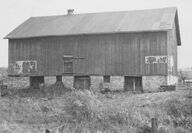
Say cheese - This photo in Sandy Williams' book, "Images of America - Hinsdale," shows on of the barns on Walker's farm, which was located near Ayres and Garfield avenues. "In addition to raising crops and livestock, Walker became one of Illinois' first cheese manufacturers. This barn likely housed the factory, producing 100-pound cheeses that were shipped to Chicago and beyond. Walker experimented with various methods and products and his farm became well-known. Recognized...
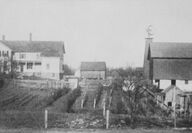
Green acres - This photo in Sandy Williams' book, "Images of America - Hinsdale," shows Walker's farm. "Located where today's Ayres Avenue meets Garfield Avenue, Walker's farm stretched to the county line. There were no houses to the south for 8 miles, only prairie and a lone grove of trees. The street, 'The Lane,' was actually the lane that cows used to reach the barn. Years later, the barn's foundation was broken down and used in paving Ravine Road....
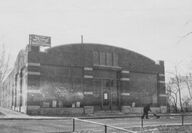
Early car dealer - This photo in Sandy Williams' book, "Images of America - Hinsdale," shows Hinsdale's first automobile dealership. "This was Hinsdale's first automobile dealership, a Ford agency built in 1917 at the southwest corner of Garfield and Hinsdale Avenues, operated by the multifaceted carpenter/contractor/realtor Henry Buchholz and his brother. Within months of opening, Henry Ford stopped for a spontaneous visit on his way to meet with International harvester's...
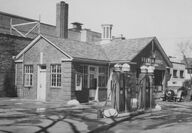
This old gas station - This photo in Sandy Williams' book, "Images of America - Hinsdale," is of the space that up until recently was home to Dips and Dogs. "This 1930 station was built on the northwest corner of Garfield Avenue and First Street. Designed by Hinsdale architect R. Harold Zook, the station was built in the Georgian style encouraged at the time by the village plan commission. The station has recently been reinvented as a popular snack shop." Today much of the...
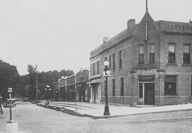
Early First Street - This photo in Sandy Williams' book, "Images of America - Hinsdale," shows the southeast corner of First and Washington streets. "In this early 1920s photograph, First Street development appears fairly complete. The bank's vault annex is shown as well as the four-store retail block built in 1912. Included here is Hinsdale's first movie theater, boasting a seating capacity of 300. To appease concerns over new 'moving picture exhibitions,' residents were...